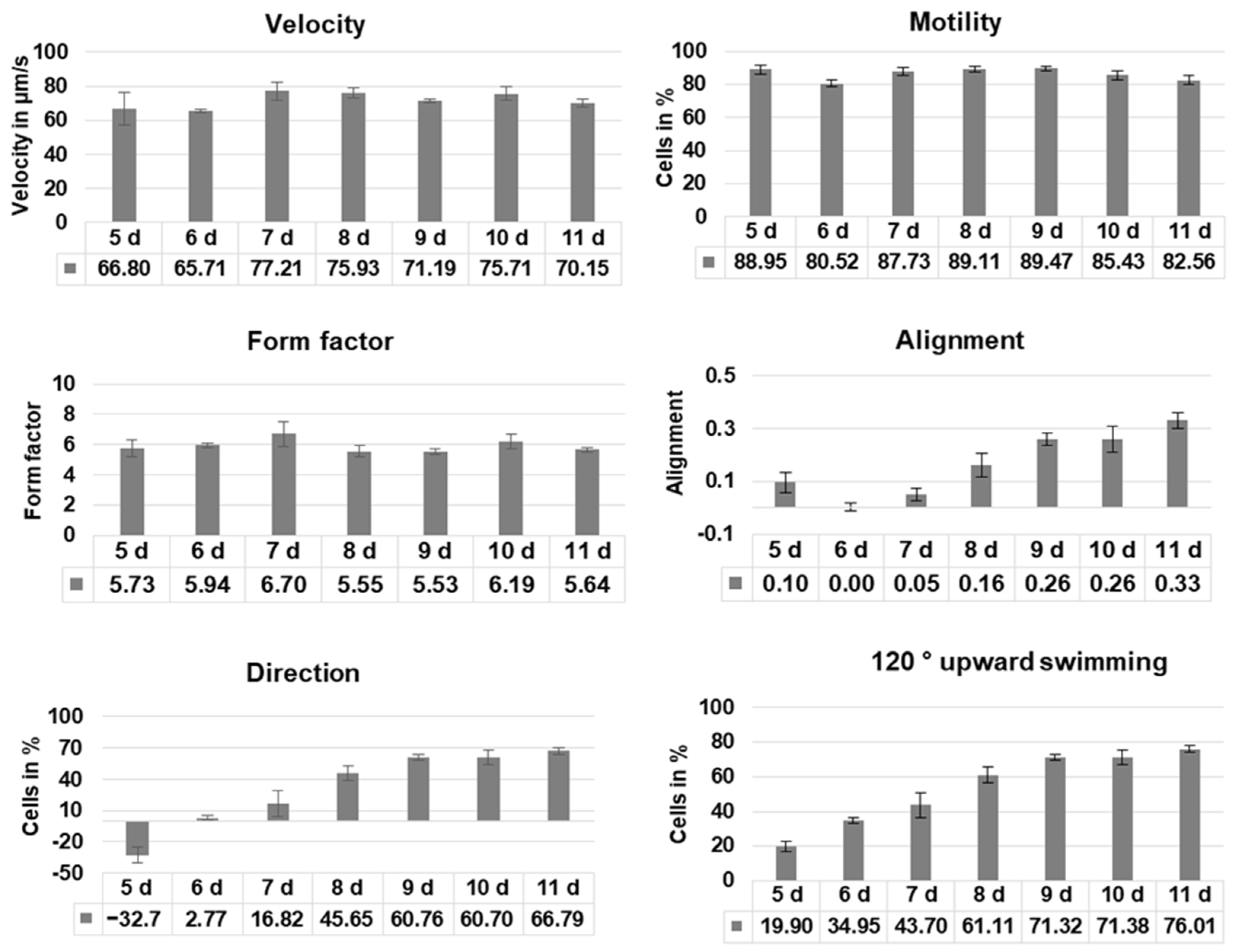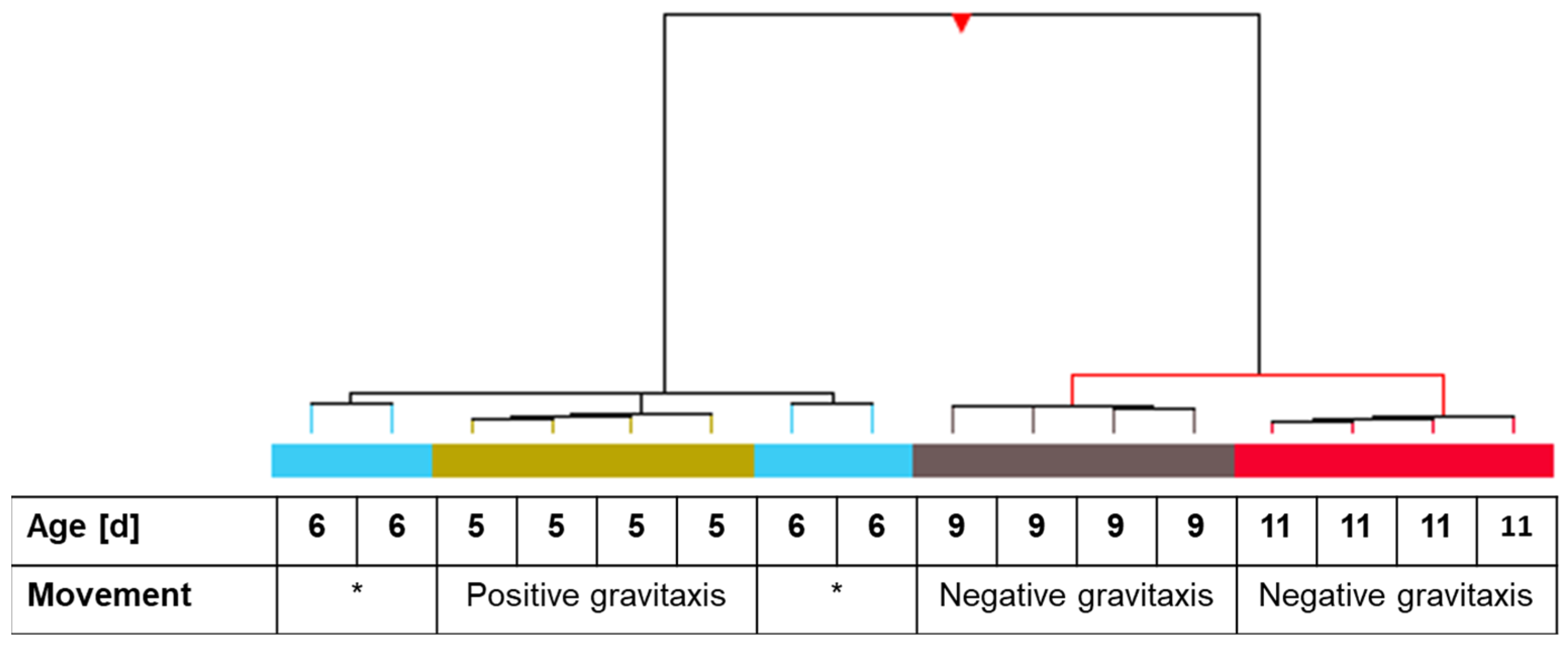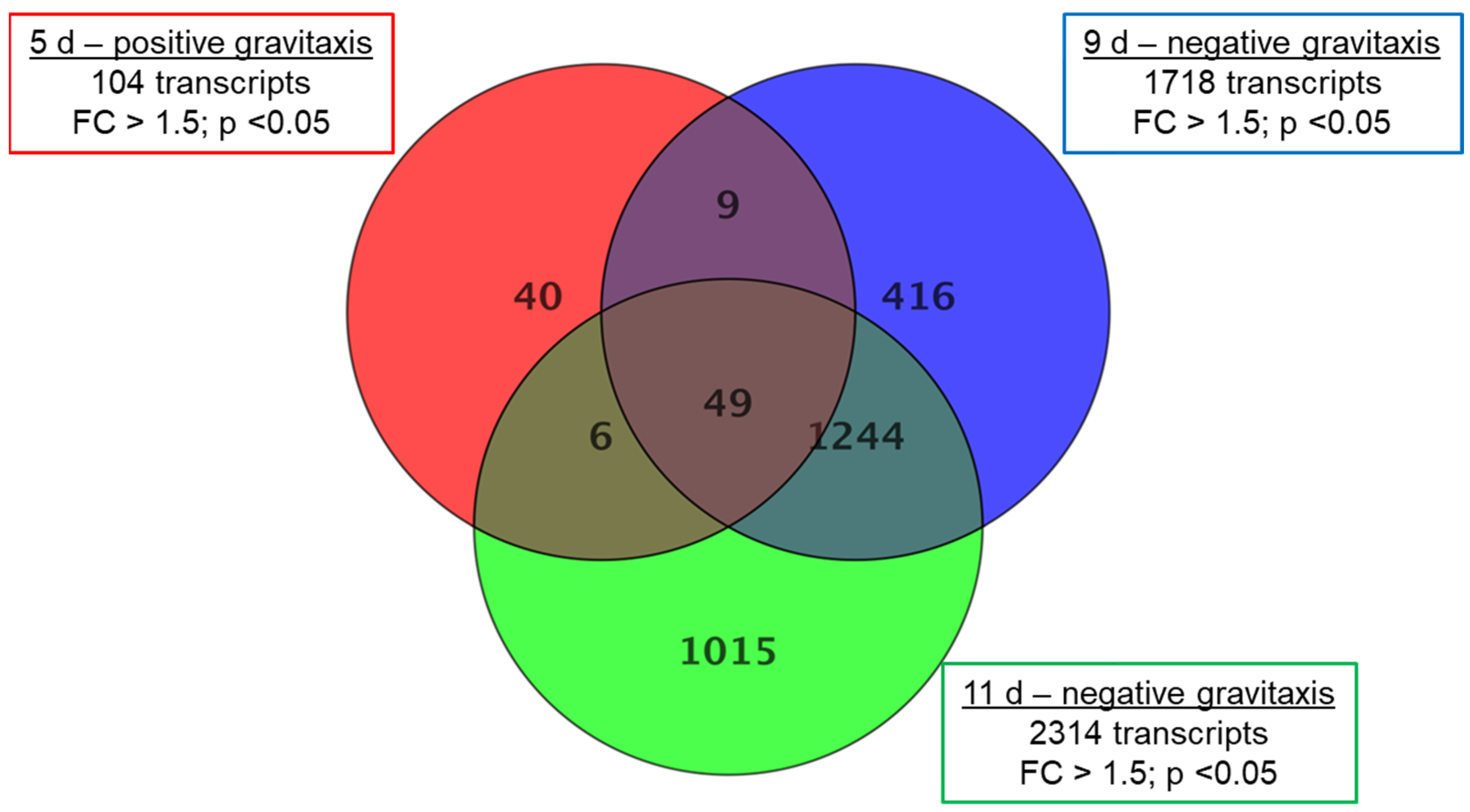Changes in Gravitaxis and Gene-Expression in an Euglena gracilis Culture over Time
Abstract
1. Introduction
2. Materials and Methods
2.1. Cells and Growth Conditions
2.2. Image Analysis
2.3. RNA Isolation
2.4. Synthesis of cDNA and Fluorescent Complementary RNA (cRNA)
2.5. Microarray Hybridization
2.6. Agilent Microarray Data Analysis and Transcript Annotation
3. Results
3.1. Movement Behavior and Gravitaxis of Euglena gracilis Cells Concerning Culture Ages
3.2. Culture-Age-Related Gene Expression Changes
3.3. Gene Set Enrichment Analysis (GSEA)
3.4. Changes of Functionally Annotated Transcripts in Euglena gracilis
3.5. Single Transcript Analysis of Sequences Differentially Regulated in Cell Culture, Showing Negative or Positive Gravitaxis, Respectively, Compared to Not-Oriented Cells
4. Discussion
5. Conclusions
Supplementary Materials
Author Contributions
Funding
Institutional Review Board Statement
Informed Consent Statement
Data Availability Statement
Conflicts of Interest
References
- Braun, M.; Böhmer, M.; Häder, D.P.; Hemmersbach, R.; Palme, K.; Häder, D.P.; Hemmersbach, R. Gravitaxis in flagellates and ciliates. In Gravitational Biology I: Gravity Sensing and Graviorientation in Microorganisms and Plants; Springer: Berlin/Heidelberg, Germany, 2018; pp. 27–45. [Google Scholar]
- Porterfield, D.M. Orientation of motile unicellular algae to oxygen: Oxytaxis in Euglena. Biol. Bull. 1997, 193, 229–230. [Google Scholar] [CrossRef]
- Iseki, M.; Matsunaga, S.; Murakami, A.; Ohno, K.; Shiga, K.; Yoshida, C.; Sugai, M.; Takahashi, T.; Hori, T.; Watanabe, M. A blue-light-activated adenylyl cyclase mediates photoavoidance in Euglena gracilis. Nature 2002, 415, 1047–1051. [Google Scholar] [CrossRef]
- Häder, D.P.; Hemmersbach, R. Euglena, a gravitactic flagellate of multiple usages. Life 2022, 12, 1522. [Google Scholar] [CrossRef]
- Yoshida, Y.; Tomiyama, T.; Maruta, T.; Tomita, M.; Ishikawa, T.; Arakawa, K. De novo assembly and comparative transcriptome analysis of Euglena gracilis in response to anaerobic conditions. BMC Genom. 2016, 17, 182. [Google Scholar] [CrossRef]
- O’Neill, E.C.; Trick, M.; Hill, L.; Rejzek, M.; Dus, R.G.; Hamilton, C.J.; Zimba, P.V.; Henrissat, B.; Field, R.A. The transcriptome of Euglena gracilis reveals unexpected metabolic capabilities for carbohydrate and natural product biochemistry. Mol. BioSyst. 2015, 11, 2808. [Google Scholar] [CrossRef]
- Cordoba, J.; Perez, E.; Van Vlierberghe, M.; Bertrand, A.R.; Lupo, V.; Cardol, P.; Baurain, D. De novo transcriptome meta-assembly of the mixotrophic freshwater microalga Euglena gracilis. Genes 2021, 12, 842. [Google Scholar] [CrossRef]
- Ebenezer, T.E.; Zoltner, M.; Burrell, A.; Nenarokova, A.; Novák Vanclová, A.M.G.; Prasad, B.; Soukal, P.; Santana-Molina, C.; O’Neill, E.; Nankissoor, N.N.; et al. Transcriptome, proteome and draft genome of Euglena gracilis. BMC Biol. 2019, 17, 11. [Google Scholar] [CrossRef] [PubMed]
- Hammond, M.; Zoltner, M.; Garrigan, J.; Butterfield, E.; Varga, V.; Lukeš, J.; Field, M.C. The distinctive flagellar proteome of Euglena gracilis illuminates the complexities of protistan flagella adaptation. New Phytol. 2021, 232, 1323–1336. [Google Scholar] [CrossRef] [PubMed]
- Zhang, W.; Mok, W.J.; Gao, J.; Sung, Y.Y.; Zhou, W. Transcriptome profile and pathway analysis of starch and sucrose metabolism in Euglena gracilis. Songklanakarin J. Sci. Technol. 2022, 44, 1048. [Google Scholar]
- Gao, P.; Zhong, Y.; Sun, C. Transcriptomic and genomic identification of spliceosomal genes from Euglena gracilis: Identification of Euglena gracilis spliceosomal genes. Acta Biochim. Biophys. Sin. 2023, 55, 1740. [Google Scholar] [CrossRef] [PubMed]
- Mangal, V.; Donaldson, M.E.; Lewis, A.; Saville, B.J.; Guéguen, C. Identifying Euglena gracilis metabolic and transcriptomic adaptations in response to mercury stress. Front. Environ. Sci. 2022, 10, 162. [Google Scholar] [CrossRef]
- Kawano, T.; Miura, A.; Naito, J.; Nishida, N.; Ishibashi, K.I.; Adachi, Y.; Ohno, N.; Naito, Y. High-parameter immune profiling and subjective health assessment of the immunomodulatory effects of paramylon-rich Euglena gracilis EOD-1: A randomized, double-blind, placebo-controlled, parallel-group study. J. Funct. Foods 2023, 109, 105804. [Google Scholar] [CrossRef]
- Yuan, A.; Sui, F.; Li, S.; Liu, Y.; Lu, X.; Lu, Y.; Fan, Y. Transcriptome analysis of the effects of different carbon dioxide concentrations on paramylon accumulation in Euglena gracilis Z. Bioresour. Technol. 2024, 393, 130114. [Google Scholar] [CrossRef]
- Krüger, J.; Richter, P.; Stoltze, J.; Strauch, S.M.; Krüger, M.; Daiker, V.; Prasad, B.; Sonnewald, S.; Reid, S.; Lebert, M. Changes of Gene Expression in Euglena gracilis Obtained during the 29th DLR Parabolic Flight Campaign. Sci. Rep. 2019, 9, 14260. [Google Scholar] [CrossRef]
- Stoltze, J.; Izydor, M.; Hainthaler, M.; Richter, P.; Schlücker, E.; Lebert, M. Euglena gracilis as a promising eukaryotic model system for fast detection of high pressure induced cell destruction. Environ. Exp. Bot. 2017, 133, 50–57. [Google Scholar] [CrossRef]
- Starr, R.C. The culture collection of algae at Indiana University. Am. J. Bot. 1964, 51, 1013–1044. [Google Scholar] [CrossRef]
- Tahedl, H.; Häder, D.P. Automated biomonitoring using real time movement analysis of Euglena gracilis. Ecotoxicol. Environ. Saf. 2001, 48, 161–169. [Google Scholar] [CrossRef] [PubMed]
- Batschelet, E. Circular Statistics in Biology; Academic Press: London, UK, 1981; ISBN 9780120810505. [Google Scholar]
- Häder, D.-P.; Lebert, M.; DiLena, M.R. Effects of culture age and drugs on phototaxis in the green flagellate, Euglena gracilis. Plant Physiol. 1987, 6, 169–174. [Google Scholar]
- Schwarzhans, J.-P.; Cholewa, D.; Grimm, P.; Beshay, U.; Risse, J.-M.; Friehs, K.; Flaschel, E. Dependency of the fatty acid composition of Euglena gracilis on growth phase and culture conditions. J. Appl. Phycol. 2015, 27, 1389–1399. [Google Scholar] [CrossRef]
- Brody, M.; Brody, S.S.; Levine, J.H. Fluorescence changes during chlorophyll formation in Euglena gracilis (and other organisms) and an estimate of lamellar area as a function of age. J. Protozool. 1965, 12, 465–476. [Google Scholar] [CrossRef] [PubMed]
- Baker, N.R.; Butler, W.L. Development of primary photochemical apparatus of photosynthesis during greening of etiolated bean leaves. Plant Physiol. 1976, 58, 526–529. [Google Scholar] [CrossRef]
- Bonaly, J.; Bre, M.H.; Lefort-Tran, M.; Mestre, J.C. A flow cytometric study of DNA staining in situ in exponentially growing and stationary Euglena gracilis. Cytometry 1987, 8, 42. [Google Scholar] [CrossRef]
- Lebert, M.; Häder, D.P. How Euglena tells up from down. Nature 1996, 379, 590. [Google Scholar] [CrossRef]
- Fujita, T.; Aoyagi, H.; Ogbonna, J.C.; Tanaka, H. Effect of mixed organic substrate on α-tocopherol production by Euglena gracilis in photoheterotrophic culture. Appl. Microbiol. Biotechnol. 2008, 79, 371. [Google Scholar] [CrossRef]
- Oda, Y.; Miyatake, K.; Kitaoka, S. Inability of Euglena gracilis Z to utilize nitrate, nitrite and urea as the nitrogen sources. Bull. Univ. Osaka Pref. Ser. B 1979, 31, 43. [Google Scholar]
- Richter, P.R.; Liu, Y.; An, Y.; Li, X.; Nasir, A.; Strauch, S.M.; Becker, I.; Krüger, J.; Schuster, M.; Ntefidou, M.; et al. Amino acids as possible alternative nitrogen source for growth of Euglena gracilis Z in life support systems. Life Sci. Space Res. 2015, 4, 1–5. [Google Scholar] [CrossRef]
- O’Neill, E.C.; Kuhaudomlarp, S.; Rejzek, M.; Fangel, J.U.; Alagesan, K.; Kolarich, D.; Willats, W.G.T.; Field, R.A. Exploring the glycans of Euglena gracilis. Biology 2017, 6, 45. [Google Scholar] [CrossRef]
- Willemsen, V.; Friml, J.; Grebe, M.; van den Toorn, A.; Palme, K.; Scheres, B. Cell polarity and PIN protein positioning in Arabidopsis require sterol methyltransferase1 function. Plant Cell 2003, 15, 612–625. [Google Scholar] [CrossRef] [PubMed]
- Men, S.; Boutté, Y.; Ikeda, Y.; Li, X.; Palme, K.; Stierhof, Y.-D.; Hartmann, M.-A.; Moritz, T.; Grebe, M. Sterol-dependent endocytosis mediates post-cytokinetic acquisition of PIN2 auxin efflux carrier polarity. Nat. Cell Biol. 2008, 10, 237–244. [Google Scholar] [CrossRef] [PubMed]
- Ivušić, F.; Šantek, B. Optimization of complex medium composition for heterotrophic cultivation of Euglena gracilis and paramylon production. Bioprocess Biosyst. Eng. 2015, 38, 1103–1112. [Google Scholar] [CrossRef] [PubMed]
- Šantek, B.; Felski, M.; Friehs, K.; Lotz, M.; Flaschel, E. Production of paramylon, a β-1,3-glucan, by heterotrophic cultivation of Euglena gracilis on a synthetic medium. Eng. Life Sci. 2009, 9, 23–28. [Google Scholar] [CrossRef]
- Takeyama, H.; Kanamaru, A.; Yoshino, Y.; Kakuta, H.; Kawamura, Y.; Matsunaga, T. Production of antioxidant vitamins, β-carotene, vitamin C, and vitamin E, by two-step culture of Euglena gracilis Z. Biotechnol. Bioeng. 1997, 53, 185–190. [Google Scholar] [CrossRef]
- Suzuki, K.; Nakashima, A.; Igarashi, M.; Saito, K.; Konno, M.; Yamazaki, N.; Takimoto, H. Euglena gracilis Z and its carbohydrate storage substance relieve arthritis symptoms by modulating Th17 immunity. PLoS ONE 2018, 13, e0191462. [Google Scholar] [CrossRef] [PubMed]
- Piovan, A.; Filippini, R.; Corbioli, G.; Costa, V.D.; Giunco, E.M.V.; Burbello, G.; Pagetta, A.; Giusti, P.; Zusso, M. Carotenoid extract derived from Euglena gracilis overcomes lipopolysaccharide-induced neuroinflammation in microglia: Role of NF-κB and Nrf2 Signaling Pathways. Mol. Neurobiol. 2021, 58, 3515–3528. [Google Scholar] [CrossRef] [PubMed]
- Ishiguro, S.; Upreti, D.; Robben, N.; Burghart, R.; Loyd, M.; Ogun, D.; Le, T.; Delzeit, J.; Nakashima, A.; Thakkar, R.; et al. Water extract from Euglena gracilis prevents lung carcinoma growth in mice by attenuation of the myeloid-derived cell population. Biomed. Pharmacother. 2020, 127, 110166. [Google Scholar] [CrossRef] [PubMed]
- Suzuki, K.; Mitra, S.; Iwata, O.; Ishikawa, T.; Kato, S.; Yamada, K. Selection and characterization of Euglena anabaena var. minor as a new candidate Euglena species for industrial application. Biosci. Biotechnol. Biochem. 2015, 79, 1730–1736. [Google Scholar] [CrossRef]
- Harada, R.; Nomura, T.; Yamada, K.; Mochida, K.; Suzuki, K. Genetic engineering strategies for Euglena gracilis and its industrial contribution to sustainable development goals: A review. Front. Bioeng. Biotechnol. 2020, 8, 790. [Google Scholar] [CrossRef]
- Gupta, S.P.; Khushboo; Gupta, V.K.; Minhas, U.; Kumar, R.; Sharma, B. Euglena Species: Bioactive compounds and their varied applications. Curr. Top Med. Chem. 2021, 21, 2620–2633. [Google Scholar] [CrossRef]
- He, J.; Liu, C.; Du, M.; Zhou, X.; Hu, Z.; Lei, A.; Wang, J. Metabolic responses of a model green microalga Euglena gracilis to different environmental stresses. Front. Bioeng. Biotechnol. 2021, 9, 662655. [Google Scholar] [CrossRef]
- Tomiyama, T.; Kurihara, K.; Ogawa, T.; Maruta, T.; Ogawa, T.; Ohta, D.; Sawa, Y.; Ishikawa, T. Wax ester synthase/diacylglycerol acyltransferase isoenzymes play a pivotal role in wax ester biosynthesis in Euglena gracilis. Sci. Rep. 2017, 7, 13504. [Google Scholar] [CrossRef]
- Aldholmi, M.; Ahmad, R.; Carretero-Molina, D.; Pérez-Victoria, I.; Martín, J.; Reyes, F.; Genilloud, O.; Gourbeyre, L.; Gefflaut, T.; Carlsson, H.; et al. Euglenatides, potent antiproliferative cyclic peptides isolated from the freshwater photosynthetic microalga Euglena gracilis. Angew. Chem. Int. Ed. Engl. 2022, 61, e202203175. [Google Scholar] [CrossRef]
- Becker, I.; Prasad, B.; Ntefidou, M.; Daiker, V.; Richter, P.; Lebert, M. Agrobacterium tumefaciens-mediated nuclear transformation of a biotechnologically important microalga-Euglena gracilis. Int. J. Mol. Sci. 2021, 22, 6299. [Google Scholar] [CrossRef]
- Khatiwada, B.; Kautto, L.; Sunna, A.; Sun, A.; Nevalainen, H. Nuclear transformation of the versatile microalga Euglena gracilis. Algal Res. 2019, 37, 178–185. [Google Scholar] [CrossRef]
- Nomura, T.; Yoshikawa, M.; Suzuki, K.; Mochida, K. Highly Efficient CRISPR-Associated Protein 9 Ribonucleoprotein-Based Genome Editing in Euglena gracilis. STAR Protoc. 2020, 1, 100023. [Google Scholar] [CrossRef] [PubMed]
- Nomura, T.; Kim, J.S.; Ishikawa, M.; Suzuki, K.; Mochida, K. High-efficiency genome editing by Cas12a ribonucleoprotein complex in Euglena gracilis. Microb. Biotechnol. 2024, e14393. [Google Scholar] [CrossRef] [PubMed]
- Hauslage, J.; Strauch, S.M.; Eßmann, O.; Haag, F.W.M.; Richter, P.; Krüger, J.; Stoltze, J.; Becker, I.; Nasir, A.; Bornemann, G.; et al. Eu:CROPIS—“Euglena gracilis: Combined regenerative organic-food production in space”—A Space Experiment Testing Biological Life Support Systems Under Lunar And Martian Gravity. Microgravity Sci. Technol. 2018, 30, 933–942. [Google Scholar] [CrossRef]





| Fold Change | 5 d | 9 d | 11 d |
|---|---|---|---|
| FC ≥ 1.5 | 104 | 1718 | 2314 |
| FC ≥ 2.0 | 11 | 526 | 758 |
| FC ≥ 3.0 | 0 | 123 | 275 |
| FC ≥ 5.0 | 0 | 9 (all downregulated) | 98 (mainly downregulated) |
| Up/down | 44/60 | 805/913 | 1115/1199 |
| Cell Culture Age | GO ID | GO Name | Number of Transcripts | Total Number of Corresponding GOs [7] |
|---|---|---|---|---|
| 5 d vs. 6 d | GO:0003677 | DNA binding | 5 | 355 |
| 9 d vs. 6 d | GO:0003677 | DNA binding | 60 | 355 |
| GO:0005739 | Mitochondrion | 41 | 1044 | |
| GO:0005886 | Plasma membrane | 11 | 1395 | |
| GO:0009190 | Cyclic nucleotide biosynthetic process | 33 | 93 | |
| GO:0016070 | RNA metabolic process | 25 | 720 | |
| GO:0016779 | Nucleotidyltransferase activity | 10 | 84 | |
| GO:0016791 | Phosphatase activity | 9 | 159 | |
| GO:0016849 | Phosphorus-oxygen lyase activity | 34 | 93 | |
| GO:0016874 | Ligase activity | 14 | 255 | |
| GO:0016887 | ATPase activity | 35 | 432 | |
| GO:0035556 | Intracellular signal transduction | 36 | 438 | |
| GO:0065008 | Regulation of biological quality | 11 | 723 | |
| 11 d vs. 6 d | GO:0002376 | Immune system process | 6 | 401 |
| GO:0003677 | DNA binding | 62 | 355 | |
| GO:0005694 | Chromosome | 8 | 294 | |
| GO:0005739 | Mitochondrion | 35 | 1044 | |
| GO:0005886 | Plasma membrane | 16 | 1395 | |
| GO:0006281 | DNA repair | 6 | 268 | |
| GO:0009190 | Cyclic nucleotide biosynthetic process | 40 | 93 | |
| GO:0015979 | Photosynthesis | 11 | 56 | |
| GO:0016070 | RNA metabolic process | 26 | 720 | |
| GO:0016757 | Transferase activity, transferring glycosyl groups | 43 | 121 | |
| GO:0016779 | Nucleotidyltransferase activity | 14 | 84 | |
| GO:0016849 | Phosphorus-oxygen lyase activity | 42 | 93 | |
| GO:0016887 | ATPase activity | 42 | 432 | |
| GO:0035556 | Intracellular signal transduction | 45 | 438 | |
| GO:0042578 | Phosphoric ester hydrolase activity | 11 | 190 | |
| GO:0042592 | Homeostatic process | 15 | 313 |
| Function | Number of Transcripts |
|---|---|
| Cell cycle | 1 |
| Dephosphorylation | 1 |
| Flagellar protein | 1 |
| Hydrolase activity | 1 |
| Meiotic cell cycle | 1 |
| Metabolism | 1 |
| Nucleotide metabolism | 1 |
| Positive gravitropism | 1 |
| Retrotransposon nucleocapsid | 1 |
| RNA-binding | 1 |
| Signal transduction | 4 |
| Transport | 2 |
| No GO | 9 |
| NA | 24 |
| Total | 49 |
Disclaimer/Publisher’s Note: The statements, opinions and data contained in all publications are solely those of the individual author(s) and contributor(s) and not of MDPI and/or the editor(s). MDPI and/or the editor(s) disclaim responsibility for any injury to people or property resulting from any ideas, methods, instructions or products referred to in the content. |
© 2024 by the authors. Licensee MDPI, Basel, Switzerland. This article is an open access article distributed under the terms and conditions of the Creative Commons Attribution (CC BY) license (https://creativecommons.org/licenses/by/4.0/).
Share and Cite
Krüger, J.; Richter, P.; Stoltze, J.; Prasad, B.; Strauch, S.M.; Krüger, M.; Nasir, A.; Lebert, M. Changes in Gravitaxis and Gene-Expression in an Euglena gracilis Culture over Time. Biomolecules 2024, 14, 327. https://doi.org/10.3390/biom14030327
Krüger J, Richter P, Stoltze J, Prasad B, Strauch SM, Krüger M, Nasir A, Lebert M. Changes in Gravitaxis and Gene-Expression in an Euglena gracilis Culture over Time. Biomolecules. 2024; 14(3):327. https://doi.org/10.3390/biom14030327
Chicago/Turabian StyleKrüger, Julia, Peter Richter, Julia Stoltze, Binod Prasad, Sebastian M. Strauch, Marcus Krüger, Adeel Nasir, and Michael Lebert. 2024. "Changes in Gravitaxis and Gene-Expression in an Euglena gracilis Culture over Time" Biomolecules 14, no. 3: 327. https://doi.org/10.3390/biom14030327
APA StyleKrüger, J., Richter, P., Stoltze, J., Prasad, B., Strauch, S. M., Krüger, M., Nasir, A., & Lebert, M. (2024). Changes in Gravitaxis and Gene-Expression in an Euglena gracilis Culture over Time. Biomolecules, 14(3), 327. https://doi.org/10.3390/biom14030327








